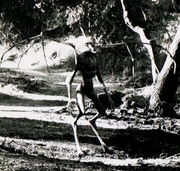The Black Goat-Man of Wittingau is an urban legend or presumably a cryptid based on a figure from Western Slavic folklore. It is a misshapen blending of human and goat-like parts with a fur that is always clammy or damp. The being is reported to live in the South Bohemian area around the town Třeboň from Renaissance period onwards.
Description[]
The creature is notable for its bipedal goat-like appearance with short horns, crooked limbs, long claws and a black wet fur. It resembles satyrs from Greek mythology or the stereotypical Medieval representation of the Devil, but sometimes it is described to have some feline elements such as pointy ears, a big round face with whiskers and dark glittering eyes or even an atrophied fur tail. It is believed to live in marshy areas, therefore it often has an interdigital webbing or very long hind legs to elegantly move in a deep mud.
The being’s name is derived from the old German exonym Wittingau, which describes the modern town Třeboň.
Behaviour[]
According to the legends, the goat-men used to live in bogs and swampy woods to avoid any interaction with humans. They retreated to uninhabited areas during the Medieval period and dwindled, but still they have to fight for their existence with advancing mankind. Being secretly and insidious by nature, they prefer to set nasty traps or to ambush only the weakest such as small children and old persons when they are left alone.
Legends[]
The local legends claim the Black Goat-Men killed watchdogs and livestock, stole babies from cradles and even tried to have sexual intercourse with maidens to produce offspring, but it is unclear to what end. Some old manuscripts (now lost volume of Rosenberg Chronicle by Václav Březan, well-known Book of Aldaraia[1], the alchemical script Monas Hieroglyphica[2]) suggest the Black Goat-Man had some unnatural powers in connection with ancient pagan gods which it should be representation of. The Renaissance occultists and their covens made efforts to communicate with the creatures from swamps offering human sacrifices in exchange for granting magic, however there is no written evidence they succeeded.
There are also some local stories about the Black Goat-Men, but the creatures are usually misinterpreted as lesser forms of devils here. This is mostly the case of the fairy tales about the famous fishpond builder Jakub Krčín z Jelčan who is said to have a carriage drawn by horned cat-like demons. The builder should have made a bargain with goat-like devil to finish the Rosenberg Pond, too.
Recent Activities[]
There are not many rumours about the Black Goat-Man of Wittingau from the Communist period (1948–1989) since the boarder marshes around Třeboň were largely a part of the Iron Curtain between Western and Eastern Europe.
Some gossips about strange bog devils came across since then, but there was nothing certain. This changes during the anthropause caused by the COVID-19 pandemic between 2020 and 2021. People were ordered to stay at home and the wildlife flourished without any distraction even in densely populated areas which leads to assumption the goat-men became also more daring during this time. There are of course no systematic evidences about the cryptid, but many seemingly unrelated reports were captured (translation from Czech attached). Luckily, there are no reported ambushes yet:
„Tak jsem to mečení zase slyšela! Chodit k Rožmberku po červené je o strach. A přitom mi všichni tvrdí že v okolí žádné kozy nechovají. Že by se tam ani nikam nevešli.“
[So, I’ve heard the bleating again! Following the red tourist line to the Rožmberk/Rosemberk fishpond is pretty scary. Yet all claim there is no goat farming around, since there is no space for it.]
– a Twitter post from 17th of March 2021
„Domorodci v Třeboni jsou pěkně škodolibí nebo nemají rádi cyklisty. Vyrazili sme na cykloprojížďku z Třeboně směrem k Majdaleně. Nikdo nikde, byl zákaz (samozřejmě jsem jel jen s přítelkyní 😊), ale kolem pekelné brány za Třeboní jsem měl intenzivní pocit, že nás z lesa někdo pozoruje. Myslel jsem, že tam někdo hledá kešku nebo sbírá houby, ale nikoho jsme neviděli. Pak se z druhé strany ozvalo mečení, které se změnilo ve smích. Kde by se tam vzala koza? Někdo si z nás udělal srandu.”
[The locals in Třeboň are a little bit spiteful or they don’t like the bikers. We started a tour from Třeboň heading Majdalena /a village nearby/. We saw no-one because the ban (I went only with my girlfriend, of course), but by the Hell Gate /a local sight deep in the forest/, I had an intensive feeling something is staring on us from the woods. I thought there is someone looking for geocaches or mushrooming, but still no-one was seen. Then the bleating came from the other side and turned into a malicious laughter soon. It couldn’t be a goat. Someone must have been kidding us!]
– a review comment from official town website
„Šly jsme včera večer přes Hrádeček od Opaťáku, už nebylo pořádně vidět, ale něco nebo někdo tam chodil v močálu! Musel to být rybář nebo nějaký zoolog z ústavu, ale nechápu jak se mohl v tom blátě hýbat tak rychle. Nechaly jsme to být, byla už tma, ale když jsme se vracely, potkaly jsme dvě důchodkyně úplně na prášky, protože jim prý něco shrbeného přeběhlo přes cestu a strašně to hýkalo a mečelo. Musely jsme jim posvítit mobilem a odvést je do města.“
[We went yesterday in the evening around Hrádeček /a local nature park/ from Opaťák /a fishpond, formally Opatovický rybník/. We didn’t see clearly, but someone or something walked in the marsh! It had to be a fisherman or some scientist from the Institute, but I completely don’t understand how was he able to move so fast through the mud. We went away, since it was already dark, but on our way back we met two elderly women. They were terrified, cause something humped run across braying and bleating awfully. We had to help them back to town shining with our phones.]
– from Facebook discussion about Czech urban legends
„Jeli jsme od Majdaleny ke Zlaté stoce a k akvaduktu a něco černého se tam brodilo vodou. Myslel jsem, že to srnec, protože to mělo paroží, ale uteklo to před námi po zadních. Ostatní si za mě pak dělili srandu, že už toho piva bylo moc.”
[We went from Majdalena to the Zlatá stoka and the aqueduct /an artificial river suppling the fishponds/ and something black was wading through the water. I considered it to be a deer because of the antlers, but it run away from us on its hind legs. The other from our group are joking me since them about my beer drinking.]
– a discussion post from Czech biker web site
Gallery[]


Black Goat-Man of Wittingau: photographed 21-11-06 south of Třeboň/Wittingau
The artistic conception of the Jersey Devil from AHS:Coven (2013). This cryptid shows remarkable alusions to the Black Goat-Man of Wittingau, although the Goat-Man has been known since the Renaissance period.
References[]
The local legends and fairy tales concerning the Black Goat-Man of Wittingau, usually as an interpretation of the lesser from of the Devil (in Czech): Pověsti na Třeboňsku | Rožmberský rok - díla Rožmberků v rybářství na Třeboňsku (12-web.cz)
The site about the Black Goat-Man of Wittingau on the Myths and Folklore Wiki (in English): Black Goat-Man of Wittingau | Myths and Folklore Wiki | Fandom
[1] The Black Goat-Man is referred only as a bog demon.
[2] Some of the glyphs and alchemical symbols in the book are presumably based on the appearance and interpretation of the Black Goat-Man.
